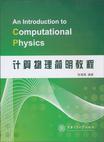计算物理简明教程
出版时间:2010-8 出版社:上海交通大学出版社 作者:张海燕 页数:259
内容概要
《计算物理简明教程》介绍了“计算物理”学科中的几种基本常用方法,具体内容包括:误差分析、有限差分和内插法、数值积分方法、矩阵算法、常微分方程差分解法、偏微分方程解法、蒙特卡罗模拟方法等。《计算物理简明教程》可供物理专业的本科生作为“计算物理”课程教材使用,也可供从事数值计算的相关专业的研究生参考。
书籍目录
Approximations, Errors and the Taylor Series1. 1Approximations and Errorsl. 1. 1Approximations1.1.2Round-off Errors1. 1.3Principles to Hold During the Numerical Calculations1.2Truncation Errors and the Taylor Series1.2. 1Truncation Errors1.2.2The Taylor Series1.2. 3Some Techniques in Numerical Computation1.3Control of Total Numerical Error1.3. 1Truncation Error1.3.2Total Numerical Error1.3.3Control of Numerical Errors 1.4Problems for Chapter I1.5Computer Work for Chapter 12Interpolation and Finite Differences;2. 1Finite Difference2. 2Newton Interpolation2. 2. 1Basis Functions2. 2. 2Newton Interpolation,-.2. 2. 3Newtons Divided-difference Interpolating Polynomial ..2. 2. 4Errors of Newton Interpolation2. 3Interpolation Formulae2. 3. 1NGF Interpolation2. 3. 2NGB Inteipolation2. 3. 3ST Interpolation2. 4Difference Quotients2.4. 1DNGF Formulae2.4. 2DNGB Formulae2. 4. 3DST Formulae2. 5Problems for Chapter 22. 6Computer Work for Chapter 23Numerical Integration3. 1Numerical Integration Methods3. 2Newton-Cotes Quadrature Rules3. 2. 1The Trapezoid Rule3.2. 2Simpsons Rule3. 2. 3Error Estimation3. 3Composite and Adaptive Quadrature3. 3. 1Composite Quadrature Rules:3. 3. 2Automatic and Adaptive Quadrature3. 4Numerical Integration of Multi-dimensional Integrals3. 5Problems for Chapter 33. 6Computer Work for Chapter 34Matrix Algebra4. 1Types of Matrices4. 2Gauss Elimination and Back Substitution4. 2. 1The Elimination of Unknowns4. 2. 2The Algorithm of Gauss Elimination and Back Substitution4. 2. 3Techniques for Improving Solutions4. 3LU Decomposition and Matrix Inversion4. 3. 1Overview of LU Decomposition4. 3. 2LU Decomposition Algorithm4. 3. 3Procedure from Gauss Elimination4. 3. 4The Matrix Inverse and Error Analysis4. 4Tridiagonal Matrices and Recursion Method4. 4. 1Tri-diagonal Systems4. 4. 2Recursion Method4. 5Iterative Methods4. 6Jacobi Method4. 6. 1The Algorithm4. 6. 2The Convergency4.7Gauss-Seidel Method (GS)4. 7. 1The Algorithm4. 7. 2The Convergency4. 8Successive Over-Relaxation Method(SOR)4.9Conjugate Gradient Method(CG)4. 9. 1The Gradient4. 9.2Steepest Descent Method4. 9. 3CG Method4. 10 Problems for Chapter 44. 11 Computer Work for Chapter 4Ordinary Differential Equations5.1Types of Differential Equations5. 2Euler Method5.2. IError Analysis5.2. 2 Stability5.2. 3Application to Vector Equations5.3The Leapfrog Methods5.3. 1Stability Analysis5.3.2Generalization to Multi-step Scheme5. 4Implicit Methods5.4. 1The Most Fundamental Scheme5.4. 2Implicit Scheme of Second OrderImproved Euler Method5.5The Runge-Kutta Method5. 5. 1The Basic Idea of Runge-Kutta Method5. 5.2Stability Analysis5.5. 3Adaptive RK Method5.6Predictor Correetor(PC) Method5. 7Boundary Value Problems and Initial Value Problems of SecondOrder5.7. 1Shooting Method-5.7.2Numerovs Method5.8Problems for Chapter 55.9Computer Work for Chapter 56Partial Differential Equations6. 1Types of Equations6.2Elliptic Equations6. 2. 1Two or More Dimensions6. 2.2ADI (alternating direction implicit) Method6. 3Hyperbolic Equations6.3. 1The FTCS Scheme6. 3.2The Lax Scheme6. 3.3Leapfrog Scheme6. 4Parabolic Equations6. 4. 1A Simple Method u FTCS Scheme6. 4. 2Implicit Scheme of First Order6. 4, 3Crank-Nieholson (CN) Scheme6. 5Five-point Stencil for 2D Poisson Equation in ElectromagneticField6. 6Problems for Chapter 66. 7Computer Work for Chapter 67Monte Carlo Methods and Simulation7. 1Probability7. 1.1Chance and Probability7. 1.2A One-dimensional Random Walk7. 1.3Probability Distribution7. 1.4Random Variables7.2Random Number Generators7. 2. 1Linear Gongruential Generators.,7. 2. 2Shift Register Generators7. 3Non-uniform Probability Distribution7.3. 1Inverse Transform Method7.3. 2Generalized Transformation Method —— Box-MtillerTechnique7. 4Monte Carlo Integration7.4. 1Splash Method (Hit or Miss Method)7.4. 2Sample Mean Method7. 4. 3Two Theorems in Probability Theory7.4. 4MC Error Analysis7. 4. 5Importance Sampling Technique7. 5Stochastic Dynamics7.5.1Random Sequences7. 5.2Stochastic Dynamics7. 6Monte Carlo Simulation and Ising Model7. 6. 1Simulation Methods7. 6. 2Random Walk Methods7. 6.3 The Ising Model7.6. 4 The Metropolis Algorithm7. 7Problems for Chapter 77. 8Computer Work for Chapter 7Bibliography
章节摘录
Round-off errors, which are often produced when a fixed number of significant digits is used, can be as large as 5 in the first neglected place or one- half in the last retained place. When a value is added to a much smaller value, the round-off can be large relative to the smaller value. For example, if 23456 is added to 10, 518 in five digits, the result is 23467, with a round-off error of ——0. 482. If 23456 is subtracted from the answer, the result is 11. Thus, in fiver digit arithmetic, (23456 + 10. 518) - 23456 = 11.0, which has an error in the third place. After the addition, the error was less than one-half in the last place, but the subtraction removed the three leading digits, 234, moving this error to the third place. This phenomenon is called cancelation. It does not cause errors but makes the size of errors already introduced larger relative to the computed result.. Thus, although round-off errors are small, their effect in the final answer can be large, so that one of the tasks of the numerical analyst is to devise or modify computational schemes to minimize the effect of these errors.
图书封面
评论、评分、阅读与下载
